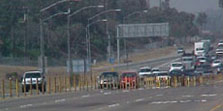
| Skip
to content |
|
 |
|
Managed Lanes and HOV FacilitiesThe 2024 National Inventory of Specialty Lanes and Highways High occupancy vehicle lanes (HOV) are the oldest incarnation of managed lanes (ML), dating to the 1970’s. Fundamentally, HOV lanes are free “carpool” lanes, open only to vehicles having two or more persons, their purpose being to promote and reward carpooling as an altruistic means of traveling, but also to enhance air quality mitigation and enable responsible regional transportation management. In the intervening decades, the term “managed lanes” has evolved to include a broad menu of specialty lanes and facilities like high occupancy toll lanes (HOT), bus-only lanes, and part-time shoulder use. Managed Lanes are informally defined as highway facilities, a lane, or a set of lanes, where operational strategies are proactively implemented and managed in response to changing conditions. They consist of three main types: price managed lanes, like HOT lanes, vehicle “eligibility” lanes, like HOV, truck or bus lanes, and vehicle “permission” lanes, like part-time open shoulders and a.m. and p.m. entry and use restrictions. Conceptually, Managed Lanes are based upon flexible operating strategies and active management of the transportation system and provide the perspective needed for integrated operations leading to improved performance.  Program InitiativesResources
|
||
|
United States Department of Transportation - Federal Highway Administration |
||